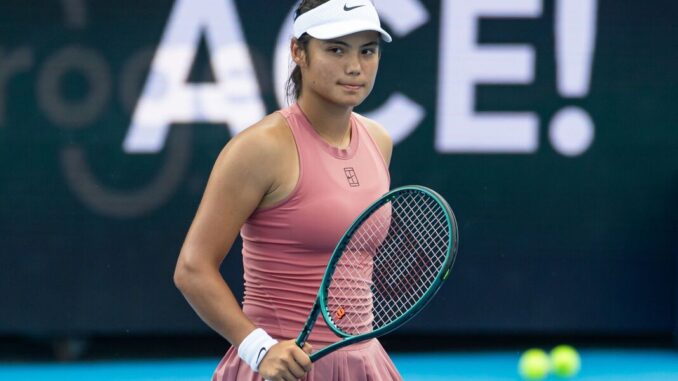
Emma Raducanu’s journey in professional tennis has always been a rollercoaster of highs and lows, marked by her stunning 2021 US Open triumph as an 18-year-old qualifier. But the 2025 edition of the tournament in Flushing Meadows delivered a harsh reality check for the British star. In a one-sided second-round clash, Raducanu was dismantled 6-1, 6-2 by the powerful Elena Rybakina, ending her campaign prematurely and leaving fans and analysts alike pondering her next steps. Despite a promising hard-court summer on the North American circuit—filled with solid runs and eye-catching victories against top opponents—the thrashing served as a stark reminder of the fine margins at the elite level.
As Raducanu, currently ranked No. 34 and holding the British No. 1 spot, regroups, insights from her former coach Mark Petchey have emerged as a guiding light. Petchey, who briefly worked with her in 2020 and rejoined her team earlier this year before stepping away due to demanding broadcast commitments, knows the 22-year-old’s game inside out. His departure paved the way for Raducanu to link up with Francisco Roig, the seasoned Spanish coach who once mentored Rafael Nadal during his formative years. The duo wasted no time, heading to Barcelona for an intensive training block to fine-tune her skills before her return to competition.
Petchey, speaking candidly about Raducanu’s path forward, outlined three clear targets that he believes should dominate her focus in the coming months. These aren’t just tactical tweaks; they’re foundational pillars designed to rebuild momentum and propel her back toward Grand Slam contention. First and foremost, he emphasized the urgency of climbing the rankings to secure a seeding spot. “If I was Emma, I’d have like three targets. Number one would be to get inside the top 32,” Petchey advised. He elaborated that breaking into the top 32 would shield her from early clashes with other seeds in major tournaments, allowing her to navigate the draw more strategically. “I don’t think that you need to be anything more than that. I think it needs to be inside 32 to be seeded for the Australian Open at the back end of the Asian swing. That would be the goal,” he continued. Ideally, Petchey envisions her settling around No. 25 or better—”So, whether that’s 25 or comfortably inside, don’t have to stress, know you’re going to be seeded.” A seeding in the 25-27 range would be particularly advantageous, minimizing the risk of facing the top four seeds as early as the third round. With the Asian swing underway, events like the WTA 500 in Seoul—where Raducanu has snagged a wildcard—represent prime opportunities to rack up vital points and inch closer to that milestone.
The second target revolves around elevating the consistency and potency of her overall game. Raducanu’s summer showed flashes of brilliance, but the Rybakina demolition highlighted vulnerabilities in maintaining pressure throughout matches. Petchey urged her to cultivate a style that’s “more impactful, more often.” This means honing her aggressive baseline play, sharpening her movement on hard courts, and ensuring she can dictate rallies against powerhouses like Rybakina. It’s about transforming those standout matches into a reliable pattern, turning potential into sustained dominance on the tour.
Finally, Petchey zeroed in on her serve, a weapon that’s shown promise but still holds untapped potential. “And number three, to keep working on that serve; to keep making sure she’s getting the maximum out of it,” he said. Acknowledging the physical constraints—Raducanu isn’t the tallest player on the circuit—Petchey remained pragmatic: “Everyone wants to talk about the fact that it can be better but there will be a limit on it just because of how tall she is. All she can do is keep working on it and make it the best that it can become subject to the natural restrictions of physics and geometry.” Recent tournaments have seen improvements in her serving stats, with more first-serve winners and fewer double faults, but consistency remains key. A sharper serve could not only win her free points but also set up her forehand, her signature shot, more effectively.
Raducanu appears to be embracing this blueprint with determination. She’s vocal about her ambition to earn a seeding for the Australian Open in January, a tournament where she’s always thrived on the fast courts. The packed schedule ahead—starting in Seoul and extending through Asia—suits her aggressive approach, allowing her to chase points while refining her game under Roig’s watchful eye. The coaching switch to Roig brings fresh perspectives; his experience with Nadal’s relentless work ethic could instill the same resilience in Raducanu, helping her overcome the injury-plagued years that followed her fairy-tale debut.
Looking beyond the immediate horizon, these targets align with Raducanu’s long-term vision of reclaiming her spot among the elite. The US Open setback, while bruising, isn’t unfamiliar territory for a player who’s battled back from surgeries and form slumps before. Petchey’s words serve as a motivational roadmap, blending practicality with optimism. As she steps onto the court in Seoul, Raducanu carries the weight of expectations but also the clarity of purpose. If she nails these goals—ranking ascent, game impact, and serve mastery—the 2026 season could mark her resurgence. Tennis, after all, rewards those who adapt and persist, and Raducanu has proven she’s built for the fight. With Roig in her corner and Petchey’s wisdom echoing, the British prodigy is poised to turn the page on this chapter and script a more triumphant narrative.
Leave a Reply